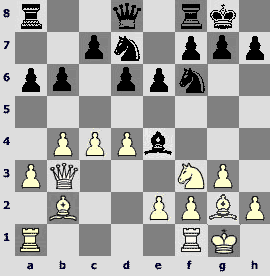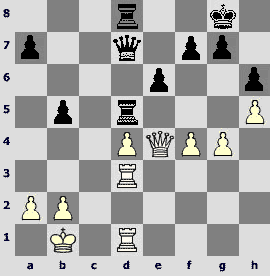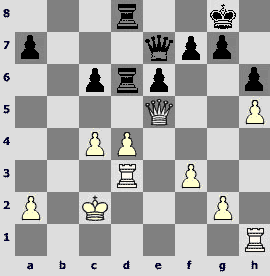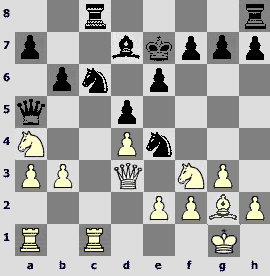14.02.2005
D.Evseev. Portrait of a chess player - Evgeny BAREYEV.
Perhaps for the first time I became more closely acquainted with creativity of Evgeny Bareyev, when studying books of Mark Dvoretsky. From these books I learnt that Evgeny had been a frequent visitor at sessions of the school of Dvoretsky-Yusupov, where he frequently delivered lectures and commented his own games. I was deeply impressed by the depth of his insight into chess. A consecutive, purposeful strategy, clear logic of the made decisions, scrupulous and nice calculation of variants were amazing. One of the first games, which produced such a bright impression, was the game against Valery Salov in Linares-92.
E.Bareyev - V.Salov E11
1.d4 ?f6 2.c4 e6 3.?f3 ?b4+ 4.?bd2 b6 5.a3 ?:d2+ 6.?:d2 ?b7 7.g3 d6 8.?g2 ?bd7 9.0-0 0-0 10.b4 ?e4 11.?c1 ?e7 12.?b3 ?fc8

13.c5! b5. 13...b:c5 14.d:c5 d:c5 15.b:c5 ?ab8 16.?e3 ?c6 17.?d4 were possible (Certainly, it would be good to move the knight on d4 without exchange of white-squared bishops and for that reason 17.?fd1!? with the idea of ?f1 and then ?d4 deserve attention. However after 17...?d5 it's not quite clear where to retreat with the queen because in case of 18.?d4 it will take time for white knight to reach the square d4, and there are no other convenient squares for the white queen) 17...?:g2 18.?:g2 ?d5 (there was a danger of 19.?c6, and in case of 18...c6 it's good 19.?f5 ?f8 20.?d6?) 19.?f3 c6 20.e4 ?5f6 21.?fd1? 20.?d6?) 19.?f3 c6 20.e4 ?5f6 21.?fd1?

Black knights are too crowded in their own camp and that fact provided White with some advantage.
14.?b2. White starts to carry out a multi-step plan. At first the bishop should be moved on f1, to give the knight f3 a free hand.
14...h6 15.?fd1 a6 16.?e1 d5 17.?f1 c6 18.a4

Then White moves the knight on a5 and screened by it the rooks are doubled along the line "a", in order to bind Black by the defence of the queen side.
18...g5 19.?a1 ?e8 20.a:b5 a:b5 21.?d2 ?g6 22.?b3 ?d8 23.?a5 ?c7 24.?a3 ?a6 25.?da1 ?ca8 26.?c1

And now White prepares the opening of the game at the king side, where the black-squared bishop, which has no opponent, must play a dominant role.
26...f6 27.f3 ?g7 28.?g2

28...e5. Leads to the desired for White opening of the game, otherwise 29.e4 is unpleasant.
29.d:e5 ?:e5. In case of 29...f:e5 there could follow 30.h4 ?e6 31.h:g5 h:g5 (31...?:g5 32.?d2?) 32.?f2? - having defended the square d4 against the intrusion of the knight, White is planning to intensify the pressure by 33.?h3.
30.f4 ?f7 31.?c3 ?e8 [31...?e7? 32.?:c6? was bad] 32.?:f6 [here to 32.e3 32...?e7 is already not bad] 32...g:f4 33.?:g7!? [to 33.g:f4 33...?h5 is unpleasant] 33...?:g7 34.g:f4 ?:e2 35.?g3!

White changed his tactics sharply, and having opened the king side, quickly moved the pieces there. Because of the lack of space it's more difficult for Black to fulfill this operation, particularly it's difficult to join the rook a6 in the game, and besides the pawn c6 needs a defence.
35...?h7 36.?f1 ?e8 37.?a2! (? 38.?ag2) 37...?e4 38.?c3 ?h8 [to 38...?g8 it's unpleasant 39.?:g8 ?:g8 40.?f6? ? ?a3-g3] 39.?d3 ?g6

40.?ag2?? Unfortunately by the checking move White has nearly destroyed the harvest of the whole preceding work. 40.?:e4 ?:e4 was winning (40...d:e4 41.?ag2?) 41.?:g6! ?:g6 42.?g2+ ?h7 43.?f6?.
40...?:a5?? But Black also made a mistake in response! When a flag (ten to one!) is falling it's not so easy to notice and to calculate 40...?:d3 41.?:d3 ?e1+! 42.?f2 ?e4!, and it's White who needs to save himself, because it's impossible to take the knight: 43.?:g6? (43.?c3!?) 43...?:f4+ 44.?f3 ?d2+ 45.?g3 ?e1+ 46.?f2 (46.?f2 ?c3+ 47.?f3 ?e3?) 46...?e3, and Black wins.
41.?:g6! 1-0
Years went by since that game, and recently I discovered a game, that resembles it very much, almost a twin, and the aggrieved party again became a famous and very strong grand master.
E.Bareyev.?𥥢 - J.Ehlvest E11
Moscow 2001
1.d4 ?f6 2.c4 e6 3.?f3 ?b4+ 4.?bd2 b6 5.a3 ?:d2+ 6.?:d2 0-0 7.g3 ?a6 8.?c2 ?b7 9.?g2 d6 10.0-0 ?bd7 11.b4 a6 12.?b2 ?e4 13.?b3

13...b5?! In the light of the just examined game it's obviously not the best decision as Black himself drives the pawn on c5.
14.c5 a5 15.?fc1 ?b8 16.?f1 h6 17.?d2 ?g6 18.e3

As in the previous game, White at first moved the bishop on f1 giving the knight a free hand and now he is preparing a transition of the latter on a5.
18...a4 19.?d1. Having moved the pawn from a6 to a4 Black secured himself against the transition of the knight on a5, but there arises another problem as the pawn b5 became vulnerable.
19...d:c5. It's deathlike to open the black-squared bishop of White, but there was a danger of very unpleasant 20.c6 or 20.c:d6 c:d6 21.?e2 with the win of the pawn b5, and to immediate 19...c6 there would follow 20.c:d6 ?:d6 21.?g2 ?ac8 22.e4? also with a strong pressure of White.
20.d:c5 c6 21.?g2 ?d5 22.e4 ?5f6 23.f4 ?c7 24.?f3 ?ad8 25.?e2 ?h8 26.?d1 ?g8 27.?f1 ?e7 28.?e3 f6 29.?d6 ?c8 30.?d2 ?fe8 31.?ad1 ?f8 32.e5?

An absolute domination!
32...?:d2 33.?:d2 f5 34.?g2 ?e7 35.?d6 ?d5 36.?c2 ?d8 37.?d4 ?e8 38.?e2 ?e7 39.?:e6 ?:e6 40.?:e6 ?c8 41.?h5 ?d7 42.?d6 ?e8 43.?:d8 ?:d8 44.e6 1-0. The game impresses! Such a first-class grand master as Jaan Ehlvest was defeated so to say "in one gate".
The subject of domination, i.e. of the full positional advantage, frequently arises in the creativity of Evgeny. Here is another bright example.
E.Bareyev - A.Shirov
Linares 1994

The position doesn't seem very clear. Certainly, White is better but Black has a pawn and a strong knight on d5 as compensation for exchange. However two exact moves of White make the situation clear.
31.?d4! (with the danger of 32.?:e6) 31...?e8 32.?e2! Domination! Black almost does not have any useful moves!
32...?c8. The only possibility to escape the immediate material losses was 32...?f8, but White has a way of strengthening the position - an advance of the pawn "f": 33.?h2 ?g8 34.f4? ? 35.f5; if 32...?f8 33.?:e6 ?c3, then 34.?e3 ?:b2 35.?c4? is the simplest, and Black is perishing because of the weakness of the square f7.
33.?:e6 ?c3

34.?ae7! 34.?:f7! ?e2+? was also possible(34...?:f7 35.?d7+?) 35.?:e2 ?:f7 36.?:b4 with won position, but White found a more convincing way.
34...?:b2 35.?e8+ ?:e8 36.?:e8+ ?h7 37.?d3+ g6 38.?c4 ?b1+ 39.?h2 ?f5 40.?d4 1-0
Typical deep insight into position, subtle sense of interaction of pieces and ulterior mechanisms of chess playing permits him, using often minimal, hardly noticeable inaccuracies of an opponent, seize (or recapture) the initiative, and collecting positional pluses little by little to convert them gradually into a point.
V.Topalov - E.Bareyev B19
Dortmund 2002
1.e4 c6 2.d4 d5 3.?c3 d:e4 4.?:e4 ?f5 5.?g3 ?g6 6.h4 h6 7.?f3 ?d7 8.h5 ?h7 9.?d3 ?:d3 10.?:d3 e6 11.?f4 ?gf6 12.0-0-0 ?e7 13.?b1 0-0 14.?e5 ?a5 15.?e4 ?:e4 16.?:e4 ?ad8

17.c4. I'd not move a pawn away from the king without necessity; it doesn't bring White any special dividends, moreover, as the given game shows, pawn c4 may become a source of serious troubles for White. In my opinion 17.g4 is more natural.
17...?:e5 18.?:e5?! A serious inaccuracy which hands the initiative to Black. 18.d:e5 is correct.
18...?d6! (it's necessary to be defended from the unpleasant danger of 19.?g4) 19.f3. Incaseof 19.g4 ?e7! (the white queen doesn't get to g4, and it's necessary to prevent the break-through g4-g5) 20.?d3 ?d7 21.?hd1 ?fd8?the weakness of the pawn d4 causes an advantage of Black.
19...?d7 20.?:d6 ?:d6 21.?e5 ?d8 22.?d3 b5!

Black has got a toehold for playing at the queen side as a result of incautious 17th move of White.
23.b3. I gather such a move was made by Veselin with a heavy heart. 23.c5? ?d5 24.?e4 ?d7 were bad, and White loses one of the pawns, as to rescue the weakness on d4 it's necessary to play ?hd1 and f4, then the pawn h5 will be unprotected: 25.f4 (or 25.g4 ?d8 26.?hd1 e5?) 25...?d8 26.?hd1 ?:h5?; perhaps the most stubborn was 23.c:b5!? ?d5 24.?e4 c:b5 25.g4 ?d7 26.?hd1 ?d8 27.f4?,

at least, keeping a material advantage, though the position of White is quite passive and Black can give another turn to the screws advancing the pawns "a" and "b". However White has some resource for a counter-play in that case: ?e3 and then g4-g5.
23...b:c4 24.b:c4 ?e7 25.?c2 ?fd8?

With such a king things look bad for White, the more so as the pawn d4 is weak anyway.
26.?c5 ?8d7 27.?hd1 ?h4 28.g4 f6 29.?b4 f5 30.?b8+ ?h7 31.?e8 ?f6 32.c5 ?d5 33.?e1 ?e7 34.?:c6 f:g4 35.f:g4 ?f2+ 36.?d1 ?:d4 37.?:d4 ?:d4+ 38.?c2

White has exchanged some material, but the king became absolutely opened, moreover a pawn is being lost.
38...?c4+ 39.?d2 ?:a2+?. It remained only to overcome some technical difficulties.
40.?e3 ?b3+ 41.?e2 ?c2+ 42.?e3 ?c3+ 43.?e2 ?e5+ 44.?d2 ?d4+ 45.?c2 ?c4+ 46.?d2 ?b4+ 47.?e2 ?b2+ 48.?e3 ?c3+ 49.?e2 ?e5+ 50.?d2 ?d4+ 51.?c2 ?c4+ 52.?d2 ?b4+ 53.?e2 ?f7 54.?:e6 ?f6 55.?d5 ?:g4+ 56.?d3 ?f5 57.?e5

Otherwise he would have to part with h5, but now White is losing a rook or a queen for a rook.
57...?g3+ 58.?d4 ?f2+ 0-1
Z.Azmaiparashvili - E.Barrev D02
Shenjan 2000
1.d4 ?f6 2.?f3 c5 3.c3. It was the second game of the quarter-final match of the World Cup. After the win in the first "black" game a draw would suit Zurab Azmaiparashvili, that's why he chose the unpretentious opening variant.
3...e6 4.g3 d5 5.?g2 ?c6 6.0-0 ?e7 7.?g5 c:d4 8.c:d4 ?b6 9.b3. First little positional achievement of Black - the square c3 is weakened.
9...?d7 10.?c3

10...?e4! 11.?a4. The only move, all the rest led to material losses: 11.?:e4? d:e4 12.?:e7 e:f3 13.?c5 f:g2 14.?:b6 g:f1?+ 15.?:f1 a:b6?; 11.?:e7? ?:c3 12.?c2 ?:e2+ 13.?:e2 ?:e7?.
11...?a5 12.?:e7 ?:e7!? An interesting possibility! Black tries to complicate the struggle by all means. Instead of castling, he brings rooks together and keeps the knight out of e5, although, in my opinion, even after the stereotyped 12...?:e7 it's not so easy for White to "drain out" the play, for example: 13.?b2 (or 13.?e5 ?:a4 14.b:a4 0-0 15.?:e4 d:e4 16.?b1 b6 17.?b5 ?a6, and the struggle goes on) 13...?c8 14.?e5 ?c3 15.?d2 ?b5 16.?bd3 f6 17.?f3 0-0 18.?fc1 ?c6 etc.
13.a3. The Exchange of queens also doesn't solve all the problems: 13.?e1 ?:e1 (probably, 13...?hc8!? is even more strong) 14.?f:e1 ?hc8 15.?ec1 b6, and the weakness of the queen side forces White to keep eyes open. In any case it's not easy at all yet to reach a cherished drawn harbour.
13...b6

14.?d3? A serious mistake. Until this moment the problems of White were mainly psychological (to make a draw as soon as possible!), but after the last move Black quickly gets almost a decisive advantage.14.?e1? ?:e1 15.?f:e1 ?a5 16.?ab1 (16.b4 ?c4?) 16...?ac8? 蠱4.b4? ?b5! was also bad (14...?a6 15.e3 ?hc8 16.?b2 is less exact) 15.e3 a5!? (15...?:d4? 16.?:d4 ?:a4 17.?:g7); but after correct 14.?b2 ?hc8 (to 14...?c3 it's possible to repeat the moves at least - 15.?a4 ?a5 16.?b2) 15.b4 ?a6 16.?d3 the position was still equal.
14...?ac8 15.?fc1

15...?b8! Very strong. 16.?e5 [16.?b2 ?:c1+ 17.?:c1 ?:a3?] 16...?:c1+ 17.?:c1 ?c8!

In advance provided interval, owing to which Black seizes the line "c". A series of the last moves of Black resembles the actions of a predator that has smelled blood, a manifestation of the notorious "killer instinct", a trait that characterizes the first-class professionals, and with that Evgeny Bareyev is endowed in full measure.
18.?d1. Forcedly. 18.?:c8 led to a checkmate: 18...?e1+ 19.?f1 ?:f2+ 20.?h1 ?:f1#, and 18.?d1 led to the loss of a pawn: 18...?:c1 19.?:c1 ?d2! 20.?:d2 (20.?d3 ?:e2?) 20...?:d2 21.?:d7 ?:d7 22.b4 ?c4?.
18...?:a4 19.?:e4. White decides to part with a piece as the position without a pawn after 19.b:a4 ?:a4 is absolutely hopeless.
19...d:e4 20.?:e4 ?c6 [20...?:b3?? 21.?b7+?] 21.?:h7 ?d5 22.?:c6+ [22.f3 ?:b3?] 22...?:c6 23.?:g7 ?d8 24.e3 ?:b3 25.?c1

25...?b2! 26.?c4 [26.?:c6 ?b1+ 27.?g2 ?e4+?] 26...?b1+ 27.?g2 ?e4+ 28.f3 ?d5 29.?c2

29...?d6! (? ?b3) 30.h4 ?b3 31.?g5+ ?d7?, and Black used his advantage with confidence (0-1).
B.Gelfand - E.Bareyev
Moscow 2002

In the opening White didn't succeed in getting an advantage and the game is approximately equal.
17.?b7?! Having knowingly accepted the worsening of pawn structure, Boris Gelfand hoped to use the activity of his pieces.
17...?c8 18.?e5. It's practically forced, unless White is going to move the rook back.
18...?:e5 19.d:e5 [19.?:e7?? ?c6?] 19...?d8! 20.?d1 ?c7 (the danger of 21...?:e5) 21.f4 ?d8 22.?:d8+ ?:d8 23.?d2 g6 24.a4 ?b8! 25.?:b8. It's impossible to take thepawn: 25.?:a7? ?b6 26.?e7 ?d8 27.?b7 ?:b7 28.?:b7 ?:d2?.
25...?:b8?

Black gradually managed to exchange active pieces of White and the better pawn structure guarantees him some advantage. Although White mustn't lose the position, Evgeny gradually managed to make use of his advantage (0-1).
An undoubted hobby-horse of Evgeny is his high ending techniques. Especially he likes two bishops, apropos this fact is reflected in his opening repertory, one of his favourite opening variants of White is the defence of Nimtsovich with 4.?c2. Sometimes straight from the opening a game transits into the ending with two bishops of White.
E.Bareyev - Z.Almasi E32
Monte Carlo 2003 (blind game)
1.d4 ?f6 2.c4 e6 3.?c3 ?b4 4.?c2 0-0 5.a3 ?:c3+ 6.?:c3 b6 7.?g5 ?b7 8.f3 h6 9.?h4 d5 10.e3 ?bd7 11.c:d5 ?:d5 12.?:d8 ?:c3 13.?h4 ?d5 14.?f2 c5 15.e4 ?e7 16.?e2 ?ac8 17.?c3 c:d4 18.?:d4 ?c5 19.?d1 ?fd8

20.?e3 ?:d1+ 21.?:d1 e5. It doesn't provide full equalization 21...f5 22.?c4 ?f7 (22...f:e4?! 23.b4!) 23.e:f5 ?:f5 24.?e1 ?:e3+ 25.?:e3 ?e7 26.?e2? (26.b4 ?e4!=).
22.?c2 ?a4 23.?d2 f5 24.e:f5 e4 25.f:e4 ?:e4+ 26.?b3 ?:c3 [26...?c5+ 27.?a2 ?:f5 28.?c4+ ?e6=] 27.?:c3 ?d5+ 28.?b4 ?:f5 29.?d3 ?d6? Here Black had a possibility to state a draw from the position of strength: 29...?c5! 30.?g1 (30.?:f5 a5+ 31.?a4 ?c6+=; 30.?e1 ?:g2) 30...?e3 31.g3, and at least there is a perpetual check - 31...a5+ 32.?a4 ?c6+ 33.?b3 ?d5+=.
30.?a6! ?e8. It looks strong - the danger of a checkmate and the pawn g2 is endangered, but...
31.?d1 ?e4+ 32.?d4 ?:d4+ 33.?:d4 ?:g2 34.?e5?

It turns out that in spite of an extra pawn, things of Black look bad as the white king is too active and the queen side is indefensible.
34...?f7. 34...?b7 35.?:b7 ?:b7 36.?b5! also didn't help, for example 36...?c5 37.?b8 a6+ 38.?:b6 ?a4+ 39.?:a6 ?:b2 40.?b5 ?f7 41.?e5 ?d3 42.a4!?and the pawn "a" is out of control.
35.?b8 ?d8 36.?:a7! ?c6+ 37.?b5 ?:a7+ 38.?:b6 ?c6 39.?b7 ?e5 40.?:g2 ?c4+ 41.?b5 ?:b2 42.?f3! The danger of 43.?e2 with catching of the knight and then ?b4-b3.
42...?d3 43.a4?. It's impossible to stop this pawn. 43...?e5 44.?d5+ ?f8 45.a5 ?e7 46.a6 ?d6 47.a7 1-0
Here are two more ending examples, where variations of two bishops and others sound...
E.Bareyev - P.Svidler D27
Elista 1997
1.d4 d5 2.c4 d:c4 3.?f3 a6 4.e3 e6 5.?:c4 c5 6.0-0 ?f6 7.d:c5 ?:d1 8.?:d1 ?:c5 9.?e2 ?bd7 10.?bd2 b6 11.?c4 ?b7 12.b3 0-0 13.?b2 ?fd8 14.?ac1

In spite of the seeming simplicity and almost (almost!) absolute symmetry, it's not so easy for Black to defend the position.
14...?f8. The disposition of the king is not very successful. Anand played 14...?ac8 15.?f1 ?d5 against Kramnik (Leon 2002), however after 16.?ce5 ?:e5 17.?:e5 a5 (17...?b7!?) 18.?a6 ?a8 19.?b5 ?ac8 20.h3 ?e4 21.?:d8+ ?:d8 22.f3 ?g6 23.e4 he also didn't obtain the absolute equality.
15.?f1 ?d5 [15...?ac8 16.?d6 ?:d6 17.?:c8 ?:c8 18.?:d6 ?c2 (18...?:f3?! 19.g:f3 ?c2 20.?:f6 ?:f6 21.?:b6?) 19.?d2 ?:d2 20.?:d2?] 16.?ce5 ?:e5 17.?:e5 ?b7 18.g4 ?d5 [18...?ac8 19.g5 ?e4 20.?d7+ ?g8 21.?:c5 ?:d1+ 22.?:d1 ?:c5 23.f3?] 19.e4 ?f6?! A strange decision. Taking into account the previous move of Black, Peter was apparently going to play 19...?f4 first, but then for some reason rejected it. Possibly because of the variant 20.?d7+ (20.?d7 ?:e2 21.?:e2 ?:e4! 22.?:f7+ ?g8?) 20...?g8 21.?:c5 b:c5 22.f3, and in case of loss of the pawn c5 the situation with rooks of different colours is very hard. However 22...?:d1+! is possible (22...?:e2 23.?:d8+ ?:d8 24.?:e2?) 23.?:d1!? (23.?:d1 ?:e2 24.?:e2 ?c6! 25.?e3 ?b5 26.?c1 ?c8 27.a4 ?e8 28.?a3 ?b8 29.?c3 c4!=) 23...?d3 (23...?d8 24.?c2! ?d2 25.?d1 ?:d1+ 26.?:d1?) 24.?c2 ?:b2 (24...f5!?) 25.?:b2?with more chances for a draw than in the game.
20.f3 h6 21.h4 ?ac8 [21...?g8!?] 22.g5 h:g5 23.h:g5 ?h5 24.?d7+ ?e7 25.?:c5 ?:d1+ 26.?:d1 b:c5? [26...?:c5? 27.?a3?] 27.?e5!?

The position of Black is already very hard.
27...?c6 28.?b8 f6 29.g:f6+ g:f6 30.?f2 ?g7 31.?h1 ?c8 32.f4 a5 33.e5!?

Increasing pressure on the black squares. There is no defence.
33...?e8 [33...?f5 34.?h7+?; 33...f:e5 34.?h7?] 34.?h7+ ?d8 35.?h8 f:e5 [35...?d7 36.e:f6?] 36.?b5 ?d7 37.?:c6 ?:c6 38.f:e5? a4 39.b:a4 ?:a4 40.?e3 ?d7 41.?a7 c4 42.?d4 ?c6 43.?h7+ ?c8 44.?b6 1-0
E.Bareyev - R.Vaganian
New Deli 2000

In the position at the diagram Black has incautiously played 41...?d8? Correct was 41...?f8??, and it's difficult for White to use his insignificant advantage.
42.f5!! An interesting break-through! 42...e5?! Probably being confused Black loses without a struggle. 42...g:f5? 43.?f4 e5 44.?e6 e:d4 45.?g2? is also hopeless, the White king is within the limits of the square of the pawn "d" and the bishop is doomed; better was 42...e:f5 43.?f4 ?c7 44.?e6 ?a6 45.?e7 ?h7

46.?:c6. In such a way White lets the black king out of the edge of the board (but the other ways also don't lead to any clear win: 46.f4 ?b8 47.?:c6 (there was already a danger of 47...?:b4) 47...?g8; 46.h5!? g:h5 47.?h4 ?h2 48.?:c6 ?h6 49.?ed8 ?f4 50.?f7+ ?g6 51.?d6 ?g5+ 52.?h3 ?c7 53.?e7+?) 46...?g8 47.h5 g:h5 48.?h4 ?f7 49.?:c7 ?:c7 50.?:h5? - perhaps, the knight ending must be winning for White, but in the game everything turns out to be far simpler.
43.d:e5 f:e5 44.?:e5 ?f6 45.?g4+ ?g7 46.f:g6 ?:g6 47.h5+ ?g7 [47...?g5 48.f4+?] 48.h6+ ?g6 49.?:f6 ?:f6 50.?e7! d4 51.?g3 1-0
However, as it is well known two bishops are strong not only in the ending, especially in the hands of such a master. I ask you once more to pay attention to first two examples at the beginning of the article, there also everything started from the advantage of two bishops. In two following games which are also very much alike, Evgeny launched a smashing attack in the middle game, relying on the strength of long-range pieces, first and foremost on that of the black-squared bishop that has no opponents.
E.Barrev - E.Rosentalis A17
Pula 1997
1.c4 e6 2.?c3 ?b4 3.?b3 ?c6 4.?f3 ?f6 5.a3 ?:c3 6.?:c3 d5?! Inaccurate move which weakens the diagonal a1-h8. It's more effective to put a pawn on d6 in such a structure.
7.e3 0-0 8.b4!

White immediately makes use of the omission of Black. The knight on c6 turns out to be unsuccessfully disposed.
8...?e4 9.?c2 ?g5 10.?b2 ?d7?! Another strange move. However the position of Black is already quite unfavourable. 11.c:d5 ?:f3+. It's forcedly, as in case of 11...e:d5 12.?:g5 ?:g5 13.b5 Black loses a pawn without any compensation.
12.g:f3 e:d5 13.?g1 f6 14.?d3 h6

15.?h7+!? Evgeny chooses a forced way, although less hasty 15.0-0-0!? ?e7 is quite strong [15...?e5 16.?h7+! loses (but not 16.?:e5?! f:e5 17.?h7+ ?h8 18.?:g7 in the view of the counter-blow 18...?f5! 19.?:f5 ?:g7 with unclear consequences) 16...?h8 17.f4 ?c4 (or 17...?g4 18.f3? ?19.?:g7! with the same result) 18.?:g7!? - in this version this blow is fatal for Black] 16.f4?, threatening with the doubling of rooks along the line "g" with a very strong attack; immediate 15.f4!? ? 0-0-0, ?g3, ?dg1? was also possible.
15...?h8 16.?:g7! ?:g7 17.?g6+ ?h8 18.?:h6 ?e7

19.?g6+! White had many tempting ways of retreat of the bishop, but none of them led to a forced win:
19.?f5+ ?g8 20.?g6+ ?g7 (20...?h8? 21.?h5+ ?g8 22.?e2?) 21.?:g7+ ?:g7 22.?:d7 ?e5? and in the ending the advantage is probably on the side of Black;
19.?d3+ ?g8 20.?e2 (20.0-0-0? ?g7 21.?g1?? ?:g1+) 20...?f7? (20...?g7? 21.?g1! ?:g1 22.?h7#) and I don't see anything more than a perpetual check in the variant 21.b5 (it's also unclear how to proceed with attack in the case of 21.?g1 ?e8 22.?g7 ?d6) 21...?e5 22.?h5+ ?e6 23.?:e5 f:e5 24.?g4+ ?d6 25.?b4+=;
19.?e4+ ?g8 20.?:d5+ ?e6 21.?:e6+ (in case of 21.?g6+ ?h8 22.?h5+ ?g8 23.0-0-0 Black can protect himself 23... 23...?f7; after 21.0-0-0 ?:d5 22.?g1+ ?f7 23.?g7+ ?e8 24.?:e7+ ?:e7? everything is also unclear) 21...?:e6 22.?g6+ ?h8 23.0-0-0 ?f7 24.?h6+ ?h7 25.?:f6+ ?:f6 26.?:f6+ ?g7? - certainly, the advantage is on the side of White, but is it sufficient for a win?!
19...?g8 20.?e2 ?g7 21.?h5 ?fd8 22.?g1 ?f8 23.?g3 ?e7 [23...?e5 24.?:e5 f:e5 25.?f5 ?e8 were losing (25...?f6 26.?h7!?) 26.?h4?] 24.?f5 ?f7

25.?:f6+! ?:f6 [25...?:f6? 26.?g5+?] 26.?h7+ ?f7 [26...?d6? 27.?g6?] 27.?g7 ?e8?! It's interesting that starting approximately with the 11th move Black was making the only possible moves all the time (although the majority of them were not complicated as they were found by exclusion), but now, I think it is not the strongest defense that could be chosen. Better was 27...?e5 28.?g6 (in case of 28.?:f7+ ?:f7 29.?h4+ ?f8 30.?g6 ?e8 31.f4 ?d6 32.f5 a5!?? the chances are mutual) 28...?:g7 29.?:g7+ ?d6 30.f4 ?b5+ 31.d3 ?:g6 32.?:g6+ ?d7 33.e4!?? - Black as before has the initiative, but it's more easy for Black to defend himself than in t
